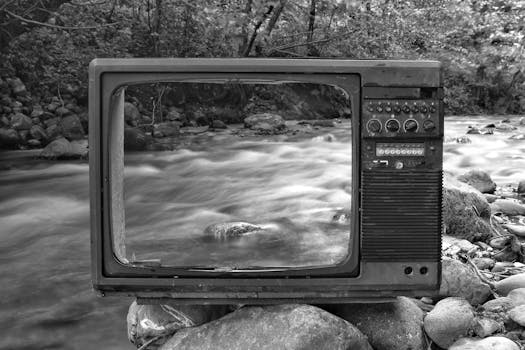Buying a used TV can seem like a great deal, but some models are best avoided. This guide reveals 8 types of TVs you should never buy used, saving you from potential headaches and wasted money.

Buying a used TV can be tempting, especially when you're on a budget. The allure of a discounted price tag can be strong. However, some types of TVs are notorious for issues that worsen with age, making them a risky second-hand purchase. This guide will walk you through eight types of TVs that you should generally avoid buying used, ensuring you get the best value and viewing experience.
Why Avoid Buying Used TVs in the First Place?
Before diving into the specifics, it's important to understand why buying a used TV can be problematic. Unlike other electronics, TVs are susceptible to several issues that are difficult to diagnose and repair economically. These include:
- Panel Degradation: LCD and OLED panels lose brightness and color accuracy over time, especially with heavy usage. This can result in a dull, washed-out picture.
- Backlight Issues: LED backlights can fail, leading to uneven brightness or dark spots on the screen. Replacement is often costly.
- Software Problems: Older smart TVs may have outdated software, lack support for current streaming apps, and pose security risks.
- Physical Damage: Scratches, dents, or internal damage can significantly impact picture quality and lifespan.
1. Old Plasma TVs
Plasma TVs offered excellent picture quality in their prime, but they are now obsolete. Here's why you shouldn't buy one used:
- High Power Consumption: Plasma TVs consume significantly more power than modern LED or OLED TVs.
- Burn-In Risk: Static images (like channel logos or video game HUDs) can permanently burn into the screen.
- Heavy and Bulky: Plasma TVs are much heavier and bulkier than modern alternatives.
Practical Tip: Even if a used plasma TV is offered for free, the electricity costs and burn-in risk make it a poor choice.
2. Early LCD TVs (CCFL Backlit)
Older LCD TVs used Cold Cathode Fluorescent Lamps (CCFL) for backlighting. These are less efficient and prone to problems:
- Dim Picture: CCFL backlights dim over time, resulting in a dull picture.
- Color Shifts: The color temperature can shift as the backlights age, leading to inaccurate colors.
- Bulky Design: CCFL backlights require a thicker panel design.
Practical Tip: Look for TVs advertised as "LED backlit" to avoid older CCFL models. LED TVs are generally more efficient and reliable.
3. 3D TVs (Unless Heavily Discounted and Used Sparingly)
3D TVs were a fad that quickly faded. While the technology isn't inherently bad, support for 3D content is virtually nonexistent:
- Limited Content: Finding 3D movies and shows is increasingly difficult.
- Uncomfortable Glasses: 3D glasses can be uncomfortable to wear for extended periods.
- Potential Eye Strain: 3D viewing can cause eye strain for some individuals.
Practical Tip: If you find a 3D TV at a very low price and are specifically interested in 3D content, proceed with caution and ensure the glasses are included and functional. Otherwise, avoid.
4. TVs with Obvious Physical Damage
This might seem obvious, but it's worth mentioning. Avoid TVs with:
- Cracked Screens: A cracked screen is a major issue and usually irreparable.
- Dents or Scratches: Even minor cosmetic damage can indicate internal problems.
- Missing Parts: Missing stands, remote controls, or other accessories can be a hassle to replace.
Practical Tip: Thoroughly inspect the TV for any signs of damage before purchasing. Turn it on and check for dead pixels or screen abnormalities.
5. TVs with a History of Repairs
A TV that has already undergone multiple repairs is likely to experience further issues down the line. This indicates underlying problems that may not be fully resolved.
- Unreliable Components: Repeated repairs suggest that the TV's components are prone to failure.
- Potential for Future Problems: The repaired TV may develop new issues in the future.
Practical Tip: Ask the seller about the TV's repair history. If it has been repaired multiple times, it's best to avoid it.
6. TVs from Unknown Brands
Stick to reputable brands with a track record of quality and customer support. Lesser-known brands may use cheaper components and have poor build quality.
- Lack of Support: Finding replacement parts or technical support for unknown brands can be difficult.
- Poor Picture Quality: Cheaper components often result in inferior picture quality.
Practical Tip: Research the brand before buying. Look for reviews and ratings to gauge its reliability.
7. Smart TVs with Outdated Software
Smart TVs rely on software for their functionality. Older models may have outdated software that is no longer supported.
- Limited App Compatibility: Older TVs may not be compatible with the latest streaming apps.
- Security Vulnerabilities: Outdated software can be vulnerable to security threats.
- Slow Performance: Older processors can result in slow and laggy performance.
Practical Tip: Check the TV's software version and compatibility with your favorite streaming apps. Consider a separate streaming device if the TV's software is outdated.
8. Projector TVs (Rear Projection)
These dinosaurs are bulky, have poor image quality by today's standards, and require frequent bulb replacements.
- Low Resolution: Often limited to lower resolutions compared to modern TVs.
- Bulb Replacement: Projector bulbs have a limited lifespan and can be expensive to replace.
- Large Footprint: These TVs take up a significant amount of space.
Practical Tip: Stick to modern flat-screen TVs for a superior viewing experience.
Conclusion
While buying a used TV can save you money, it's crucial to be cautious and avoid certain types of TVs that are prone to problems. By following these guidelines, you can increase your chances of finding a reliable used TV that provides a good viewing experience without breaking the bank. Remember to thoroughly inspect the TV, ask questions about its history, and prioritize reputable brands and newer technologies. Happy viewing!
